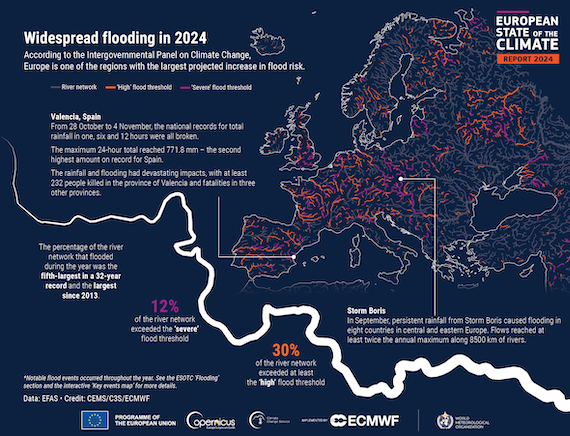Ann Arbor (Informed Comment) – The Copernicus Climate Change Service (abbreviated as C3S) has just issued The European State of the Climate for 2024.
These scientists report that last year was the hottest ever in Europe, which is the continent that is heating up faster than any other. They write, “60% of Europe saw more days than average with at least ‘strong heat stress’.” There are, however, parts of Asia, like the Middle East and South Asia, that are also heating up at twice the global average.
Southeastern Europe suffered more than the west from heat waves last year. The authors write that “there were six heatwaves during summer 2024, including the region’s longest and second most severe heatwave on record.” They add that in the summer of 2024 in southeastern Europe, on average the heat felt over 6°F (3.3°C) hotter than normal for the entire summer. There were 66 days when the “feels-like” temperature hit at least 90°F (32°C), which signals dangerous heat. That’s more than double the usual 29 days -— and the highest number ever recorded.
The worst day was August 13, when nearly the entire region (99%) was hit by strong heat, and more than half (53%) experienced even more extreme conditions, with “feels-like” temperatures over 100°F (38°C).

File. Photo of Athens by Karthik B K on Unsplash
They write that nights offered little relief last summer in southeastern Europe, pointing out that hot nighttime temperatures can be especially harmful because the body doesn’t get a chance to cool down. They say that a record 23 “tropical nights” -— when the low temperature stays above 68°F (20°C) -— were recorded. The report notes that that’s nearly triple the usual eight, and well above the previous record of 16 nights back in 2012. I’m old, and I can tell you that in my childhood the terms “Europe” and “tropical” never occurred in the same sentence.
The seas around Europe have also heated up, more than any others. The average temperature of these seas was 0.7°C [1.26º F.] above average. We saw temperatures 1.2º C. [2.16º F.] above average in the Mediterranean Sea.
When I was a kid living in France, my parents took the family on beach vacations in Normandy in the summers. It was cold. A decade before, when the Allied troops had landed there, the water temperature in June was estimated at between 45º F. (7.2º C.) and 50º F. (10º C.). Nowadays in summer the water temperature is more like 19º C / 66.2º F.
That’s a tremendous change, and while it may be better for swimming, warm oceans are very, very dangerous. The seas will get much hotter before it is all over, and it will make trouble for human beings. Destructive storms brew over hot water, which put extra moisture into the air that then falls on land. Valencia in Spain suffered an especially destructive days-long downpour that caused massive flooding. Storm Boris moved west to east over the hot Mediterranean, funneling its moisture into central Europe and swelling the rivers and causing floods. The report observes, “In 2024, storms and flooding affected an estimated 413,000 people, resulting in the loss of at least 335 lives.”
The report also contains this passage: “Between 1960 and 2010, river flood hazards increased in western and central Europe and the United Kingdom by 11% per decade . . . The most recent three decades had the highest number of floods in the past 500 years.” In contrast, southeastern Europe has started seeing droughts and more wildfires.
Via Copernicus Climate Service, EU Commission. Creative Commons Attribution 4.0 International licence
On another front, Europe is losing its glaciers. The report notes, “glaciers in Scandinavia and Svalbard saw their highest rates of mass loss on record.”
As the United States scientific establishment is being destroyed by the Trump administration, it will be up to others to monitor our global climate breakdown, caused by our burning coal, fossil gas and petroleum.
The European Union’s executive arm, the European Commission, established the Copernicus Program, which has six sections, one of them being C35. Copernicus is focused on detecting threats and developing resiliency responses. Of course, it won’t help Americans in climate disaster zones, but it is great for Europe, who mostly haven’t elected climate-change-denying assholes.



 © 2025 All Rights Reserved
© 2025 All Rights Reserved